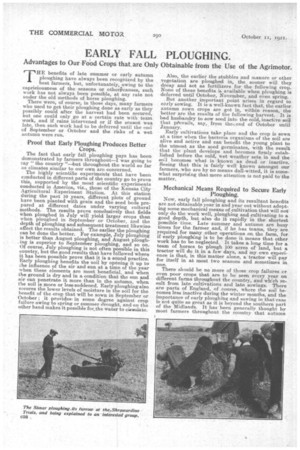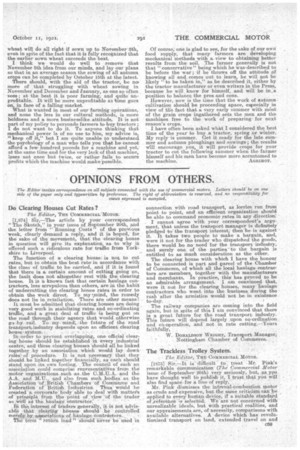EARLY FALL PLOUGHING.
Page 48

Page 49

If you've noticed an error in this article please click here to report it so we can fix it.
Advantages to Our Fdod Crops that, are Only Obtainable from the Use of the Agrimotor.
THE benefits of late summer or early autumn ploughing have always been recognized by the best farmers, but, unfortunately, owing to the capriciousness of the seasons or otherkauses such work has not always been possible, at any rate not under the old methods of horse ploughing.
There were, of course, in those days, many farmers who used to get their ploughing done as early as they possibly could after the harvest had been secured, but one could only go at a certain rate with team work, and if rains intervened or if the season was late, then such work had to be deferred until the end of September or October and the rieks of a, wet autumn were run.
Proof that Early Ploughing Produces Better Crops.
The fact that early fall ploughing pays has been demonstrated by farmers throughout—I was going to ray "the country "—but throughout the world so far as climates similar to our own are concerned.
The highly scientific experiments that have been conducted in different parts of the country go to prove this, supported • by the most scientific experiments conducted in America, viz., those of the Kansas City Agricultural , Experiment Station. At this station during the past 10 years, different plots of ground have been planted with grain and the seed beds prepared at different dates under varying cultural methods. The results prove conclusively that fields When ploughed in July will yield larger crops than when ploughed in September or October, and the depth of ploughing and subsequent treatment likewise. affect the results obtained. The earlier the ploughing can be done the better. For example, July ploughing is better than August ploughing, and August plough. ing is superior to September ploughing, and so on. Of course, July ploughing is not often possible in this country, but the good results that have followed where it has been possible prove that it is a sound practice. Early ploughing benefits the soil by opening it up to the influence of the air and sun at a time of the year when these elements are most beneficial, and when the ground is dry and in a condition that the sun sad air can penetrate it more than in the autumn, when the soil is more or leas soddened. Early ploughing also secures the lower levels of moisture in the soil for the benefit of the crop that will be sown in September or October ; it provides, in some degree against crop failure owing to spring or summer drought, and on the other hand makes it possible for the water to ciraulate. Also, the earlier the stubbles and manure or other vegetation are ploughed ha, the sooner will they decay and act as fertilizers for the following crop. None of these benefits is available when ploughing is deferred until October' November,• and even spring.
But another important point arises in regard to early sowing. It is.a well-known fact that, the earlier autumn sown crops are got in, within reason, the better are the results of the following harvest.. It is had husbandry to sow seed into the cold, inactive soil that pfevails, say, from theaend of October until January. Early cultivations take place and the crop is sown at a time. when the bacteria organisms of the soil are alive and active and can benefit the young plant to the utmost as the seed germinates, with the result that the plant develops and becomes firmly established before the cold, wet weather sets in and the e,oil becomes what is known as dead or inactive. Seeing that this is fairly well known amongst our farmers, who are by no means dull-witted, it is somewhat surprisi:ng that more attention is not paid to the matter.
Mechanical Means Required to Secure Early Ploughing.
Now. early fall ploughing and its resultant benefits are not obtainable year in and year out without adopting some mechanical means of cultivation that will not only do the work well, ploughing and cultivating to a good depth, but also do it rapidly in the shortest passible time. Late summer and autumn are busy times for the farmer and, if he has teams, they are required for many other operations on, the farm, for if early plougling is to be done it means that other work ha.s to be neglected. It takes a long time for a team of horses to plough 100 acres of land, but a tractor will do it in a few days, and my own experience is that, in this matter alone, a tractor will pay for itself in at most two seasons and sometimes in one.
There should be no more of those crop failures or even poor crops that are to be seen every year on different farms throughout the country, and wlich re-. sult from late cultivations and late sowings. There are parts of England, of course, where the soil be. comes less inactive during the winter months, and the importance of early ploughiag and sowing in that case is not quite so great as it is beyond the southern part of the Midlands. It has been generally, thought by most farmers throughout the country that autumn
wheat will do all right if sown up to November' 5th, even in spite of the fact that it is fully recognized that the earlier sown wheat succeeds the best.
I think we would do well to remove that November 5th idea from our minds, and lay our plans so that in an average season the sowing of all autumn crops can be completed by October 15th at the latest. There should, with the aid of the tractor, be no more of that struggling with wheat sowing in November and December and January, as one so often sees; at the best it is poor farming, and quite unprofitable. It will be more unprofitable as time goes on in face of a falling market.
on, is wanted in most of our farming operations, and none the less in our cultural methods, is more boldness and a more businesslike, attitude. It is not part of my policy to persuade farmers to buy tractors ; I do not want to do it. To anyone thinking that mechanical power is of no use to him, my advice is, "keep off it," but I am quite unable to understand the psychology of a man who tells you that he cannot afford a few hundred pounds for a machine and yet, at the same time and for the very lack of that machine, lose not once but twice, or rather fails to secure profits which the machine would make Posaible.
Of course, one is glad to see, for the sake of our own food supply, that many farmers are developing mechanical methods with a view to obtaining bettor results from the soil. The farmer generally is not that conservative" being which he was-described to be before the war; if he throws off the attitude of knowing all and.comes out to learn, he will not be likely to be taken in," as he described it, either by the tractor manufacturer or even writers in the Press, because he will know for himself, and will be in, a position to balance the pros and cons. however, now is the time that the work of autumn cultivation should be proceeding apace, especially in view of thie fact that a very early summer with most of the grain crops ingathered sets the men and the machines free to the work of preparing for next season's crops. I have often been asked what I considered the best time of the year to buy a 'tractor, spring or winter. My reply is summer. Get it ready for the late summer and autumn ploughings and :sowings ; the results will encourage you it will provide crops for your tractor to cut the following surnreer when the farmer himself and his men have become more accustomed to
the machine. A.GRIMOT.




















































